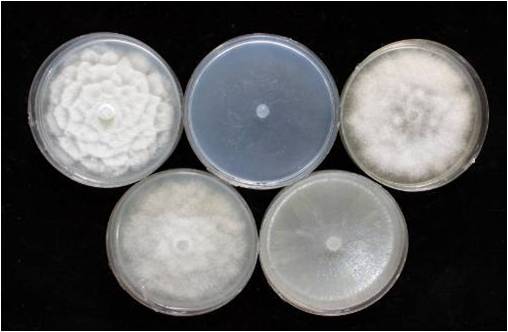Gallery
Image Type
Morphological Structure
Clades
Phytophthora spp. in subclade 8a: Morphological Tabular key (PDF) and Tabular key legends (PDF) in IDphy2 KEY SECTION. Notice the data of P. pseudocryptogea Ex-type CBS 139749 = S&T BL 183. Gloria Abad, USDA S&T.
Phytophthora spp. in subclade 10b: portion of the seven-loci ML phylogeny featuring the type cultures of 212 described species (by T. Bourret). Notice the position of P. pseudogallica Ex-type CBS 149206. Gloria Abad, USDA S&T.
Phytophthora spp. in subclade 10b: Morphological Tabular key (PDF) and Tabular key legends (PDF) in IDphy2 KEY SECTION. Notice the data of P. pseudogallica Ex-type CBS 149206. Gloria Abad, USDA S&T.
Phytophthora spp. in subclade 10a: portion of the seven-loci ML phylogeny featuring the type cultures of 212 described species (by T. Bourret). Notice the position of P. pseudokernoviae Ex-type CBS 148796. Gloria Abad, USDA S&T.
Phytophthora spp. in subclade 10a: Morphological Tabular key (PDF) and Tabular key legends (PDF) in IDphy2 KEY SECTION. Notice the data of P. pseudokernoviae Ex-type CBS 148796. Gloria Abad, USDA S&T.
Phytophthora spp. in subclade 8b: portion of the seven-loci ML phylogeny featuring the type cultures of 212 described species (by T. Bourret). Notice the position of P. pseudolactucae Ex-type CBS 137103 = S&T BL 118. Gloria Abad, USDA S&T.
Phytophthora spp. in subclade 8b: Morphological Tabular key (PDF) and Tabular key legends (PDF) in IDphy2 KEY SECTION. Notice the data of P. pseudolactucae Ex-type CBS 137103 = S&T BL 118. Gloria Abad, USDA S&T.
Phytophthora spp. in subclade 9b: portion of the seven-loci ML phylogeny featuring the type cultures of 212 described species (by T. Bourret). Notice the position of P. pseudopolonica selected specimen CBS 142610 = S&T BL 221. Gloria Abad, USDA S&T.
Phytophthora spp. in subclade 9b: Morphological Tabular key (PDF) and Tabular key legends (PDF) in IDphy2 KEY SECTION. Notice the data of P. pseudopolonica selected specimen CBS 142610 = S&T BL 221. Gloria Abad, USDA S&T.
Phytophthora spp. in subclade 6a: portion of the seven-loci ML phylogeny featuring the type cultures of 212 described species (by T. Bourret). Notice the position of P. pseudorosacearum Ex-type CBS 143061 = S&T BL188. Gloria Abad, USDA S&T.
Phytophthora spp. in subclade 6a: Morphological Tabular key (PDF) and Tabular key legends (PDF) in IDphy2 KEY SECTION. Notice the data of P. pseudorosacearum Ex-type CBS 143061 = S&T BL188. Gloria Abad, USDA S&T.
 colony morphology after 5 d growth at 20ordm;C on carrot agar, V8 agar, malt extract agar, and potato dextrose agar (from left to right)
colony morphology after 5 d growth at 20ordm;C on carrot agar, V8 agar, malt extract agar, and potato dextrose agar (from left to right)
colony morphology after 5 d growth at 20ºC on carrot agar, V8 agar, malt extract agar, and potato dextrose agar (from left to right)
 persistent, nonpapillate, predominantly ovoid sporangia with both nested and extended internal proliferation; scale bar = 25micro;m
persistent, nonpapillate, predominantly ovoid sporangia with both nested and extended internal proliferation; scale bar = 25micro;m
persistent, nonpapillate, predominantly ovoid sporangia with both nested and extended internal proliferation; scale bar = 25µm
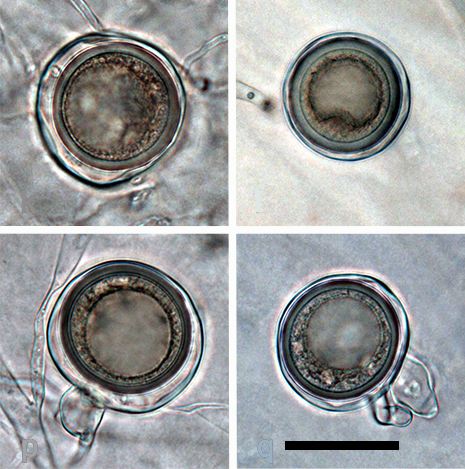 oogonia containing aplerotic oospores, with large ooplasts which were pale brown on maturity; antheridia exclusively paragynous, generally situated adjacent to the oogonial stalk; scale bar = 25micro;m
oogonia containing aplerotic oospores, with large ooplasts which were pale brown on maturity; antheridia exclusively paragynous, generally situated adjacent to the oogonial stalk; scale bar = 25micro;m
oogonia containing aplerotic oospores, with large ooplasts which were pale brown on maturity; antheridia exclusively paragynous, generally situated adjacent to the oogonial stalk; scale bar = 25µm
Phytophthora spp. in Clade 3: portion of the seven-loci ML phylogeny featuring the type cultures of 212 described species (by T. Bourret). Notice the position of P. pseudosyringae Ex-type CBS 111772 = S&T BL 51G. Gloria Abad, USDA S&T.
Phytophthora spp. in Clade 3: Morphological Tabular key (PDF) and Tabular key legends (PDF) in IDphy2 KEY SECTION. Notice the data of P. pseudosyringae Ex-type CBS 111772 = S&T BL 51G. Gloria Abad, USDA S&T.
 Phytophthora pseudosyringae (CPHST BL 51G) colonies of the ex-type grown for 7 days on (a) V8reg; Agar, (b) potato dextrose agar, and (c) malt extract agar; photo by Krysta Jennings and Leandra Knight, USDA-APHIS-PPQ
Phytophthora pseudosyringae (CPHST BL 51G) colonies of the ex-type grown for 7 days on (a) V8reg; Agar, (b) potato dextrose agar, and (c) malt extract agar; photo by Krysta Jennings and Leandra Knight, USDA-APHIS-PPQ
Phytophthora pseudosyringae (CPHST BL 51G) colonies of the ex-type grown for 7 days on (a) V8® Agar, (b) potato dextrose agar, and (c) malt extract agar; photo by Krysta Jennings and Leandra Knight, USDA-APHIS-PPQ
 Phytophthora pseudosyringae (ex-type CPHST BL 51G) asexual phase: (a) sporangia in sporangiophores, (b) coralloid mycelia; photos by Gloria Abad, USDA-APHIS-PPQ.
Phytophthora pseudosyringae (ex-type CPHST BL 51G) asexual phase: (a) sporangia in sporangiophores, (b) coralloid mycelia; photos by Gloria Abad, USDA-APHIS-PPQ.
Phytophthora pseudosyringae (ex-type CPHST BL 51G) asexual phase: (a) sporangia in sporangiophores, (b) coralloid mycelia; photos by Gloria Abad, USDA-APHIS-PPQ.
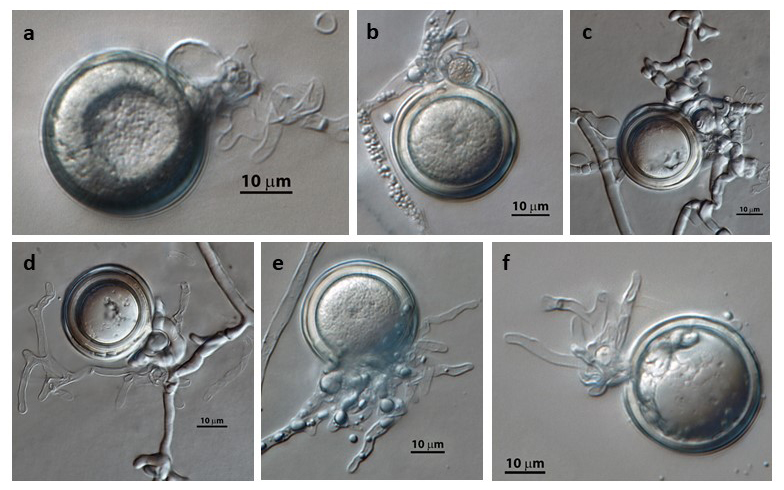 Phytophthora pseudosyringae (ex-type CPHST BL 51G) sexual phase: gametangia with plerotic or slightly aplerotic oospores (andash;f), paragynous antheridia (a, b), and with knotted hyphae (cndash;f); photos by Vickie Brewster, USDA-APHIS-PPQ.
Phytophthora pseudosyringae (ex-type CPHST BL 51G) sexual phase: gametangia with plerotic or slightly aplerotic oospores (andash;f), paragynous antheridia (a, b), and with knotted hyphae (cndash;f); photos by Vickie Brewster, USDA-APHIS-PPQ.
Phytophthora pseudosyringae (ex-type CPHST BL 51G) sexual phase: gametangia with plerotic or slightly aplerotic oospores (a–f), paragynous antheridia (a, b), and with knotted hyphae (c–f); photos by Vickie Brewster, USDA-APHIS-PPQ.
 Large group of dead and dying mature trees of Nothofagus obliqua in Britain caused by Phytophthora pseudosyringae ; photo by Bruno Scanu and Joan Webber,nbsp;Forest Research, Alice Holt, Farnham, UK.
Large group of dead and dying mature trees of Nothofagus obliqua in Britain caused by Phytophthora pseudosyringae ; photo by Bruno Scanu and Joan Webber,nbsp;Forest Research, Alice Holt, Farnham, UK.
Large group of dead and dying mature trees of Nothofagus obliqua in Britain caused by Phytophthora pseudosyringae; photo by Bruno Scanu and Joan Webber, Forest Research, Alice Holt, Farnham, UK.
 Thinning, wilting and dieback of the entire crown on Nothofagus obliqua in Britain caused by Phytophthora pseudosyringae ; photo by Bruno Scanu and Joan Webber,nbsp;Forest Research, Alice Holt, Farnham, UK
Thinning, wilting and dieback of the entire crown on Nothofagus obliqua in Britain caused by Phytophthora pseudosyringae ; photo by Bruno Scanu and Joan Webber,nbsp;Forest Research, Alice Holt, Farnham, UK
Thinning, wilting and dieback of the entire crown on Nothofagus obliqua in Britain caused by Phytophthora pseudosyringae; photo by Bruno Scanu and Joan Webber, Forest Research, Alice Holt, Farnham, UK
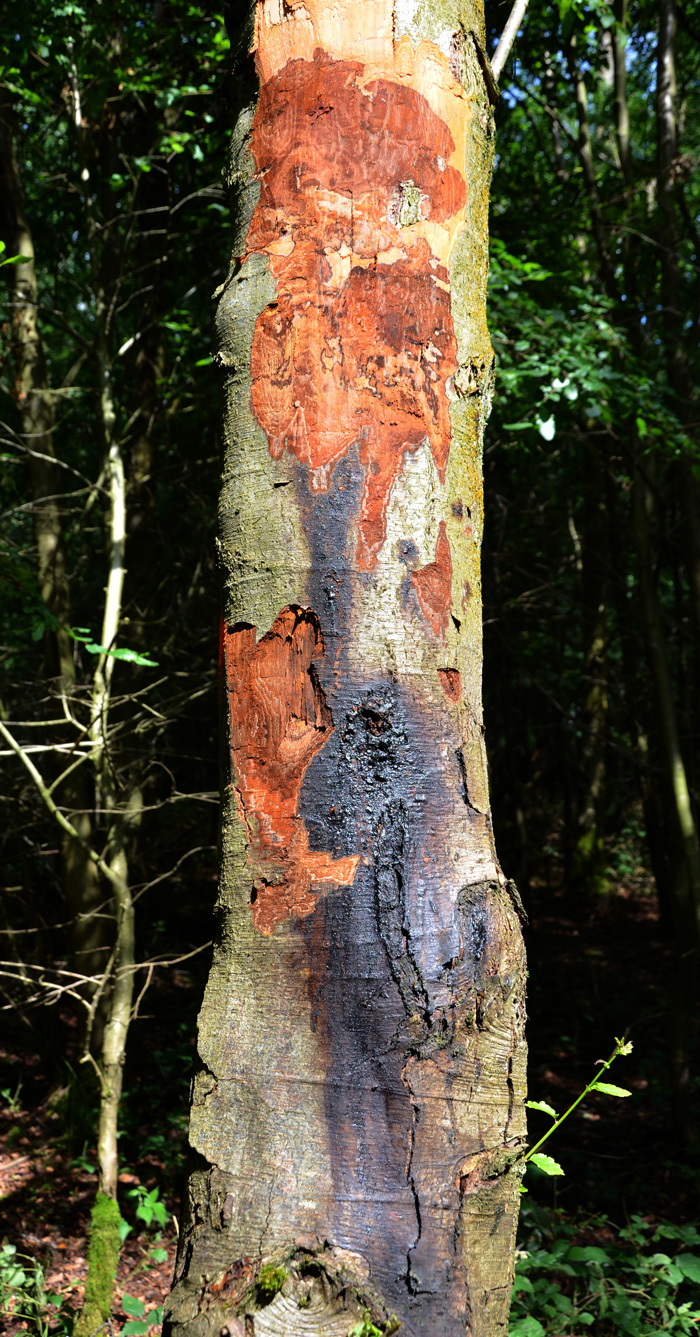 Extensive aerial bleeding lesion on the main stem of a Nothofagus obliqua tree in Britain caused by Phytophthora pseudosyringae ; photo by Bruno Scanu and Joan Webber,nbsp;Forest Research, Alice Holt, Farnham, UK
Extensive aerial bleeding lesion on the main stem of a Nothofagus obliqua tree in Britain caused by Phytophthora pseudosyringae ; photo by Bruno Scanu and Joan Webber,nbsp;Forest Research, Alice Holt, Farnham, UK
Extensive aerial bleeding lesion on the main stem of a Nothofagus obliqua tree in Britain caused by Phytophthora pseudosyringae; photo by Bruno Scanu and Joan Webber, Forest Research, Alice Holt, Farnham, UK
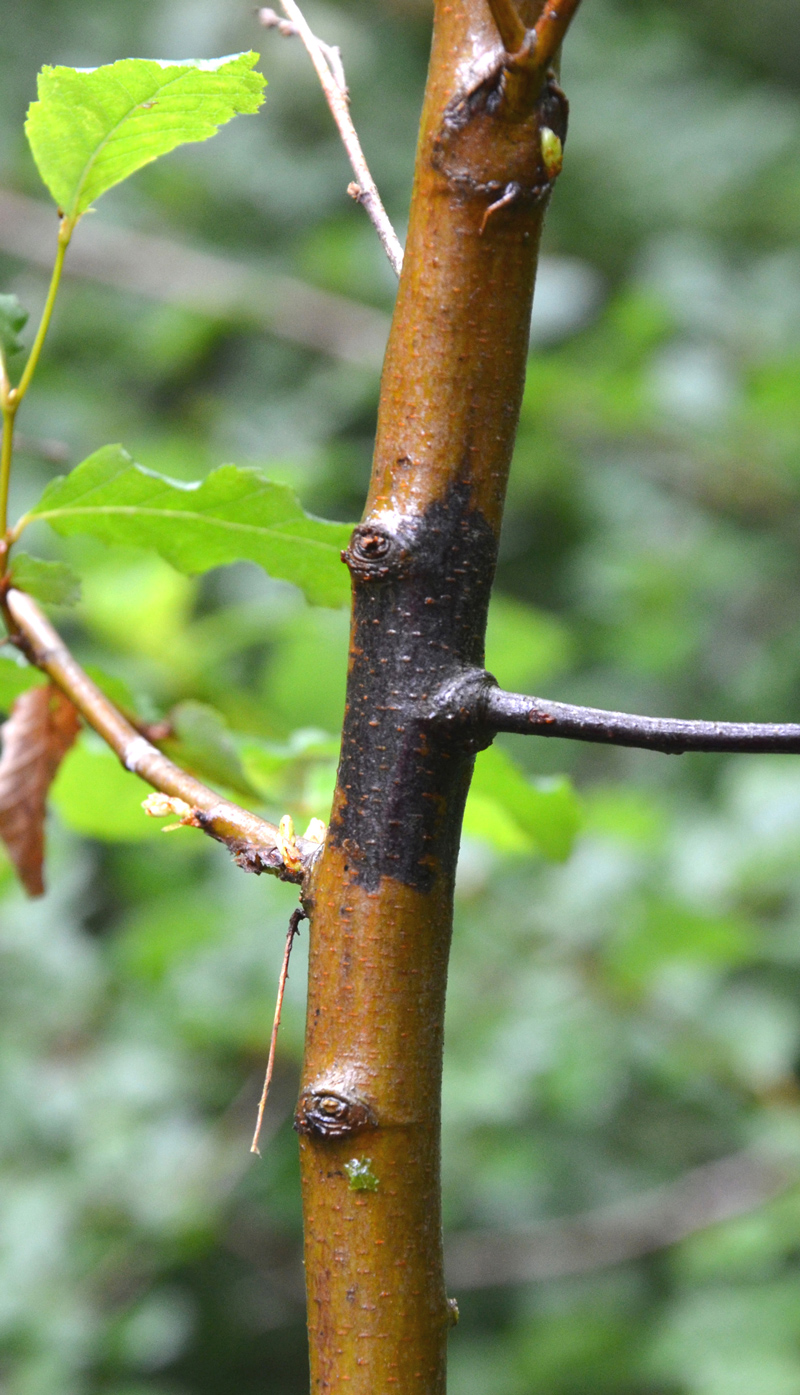 Necrotic and sunken lesion on twig of Nothofagus obliqua in Britain caused by Phytophthora pseudosyringae ; photo by Bruno Scanu and Joan Webber,nbsp;Forest Research, Farnham, Alice Holt, UK
Necrotic and sunken lesion on twig of Nothofagus obliqua in Britain caused by Phytophthora pseudosyringae ; photo by Bruno Scanu and Joan Webber,nbsp;Forest Research, Farnham, Alice Holt, UK
Necrotic and sunken lesion on twig of Nothofagus obliqua in Britain caused by Phytophthora pseudosyringae; photo by Bruno Scanu and Joan Webber, Forest Research, Farnham, Alice Holt, UK
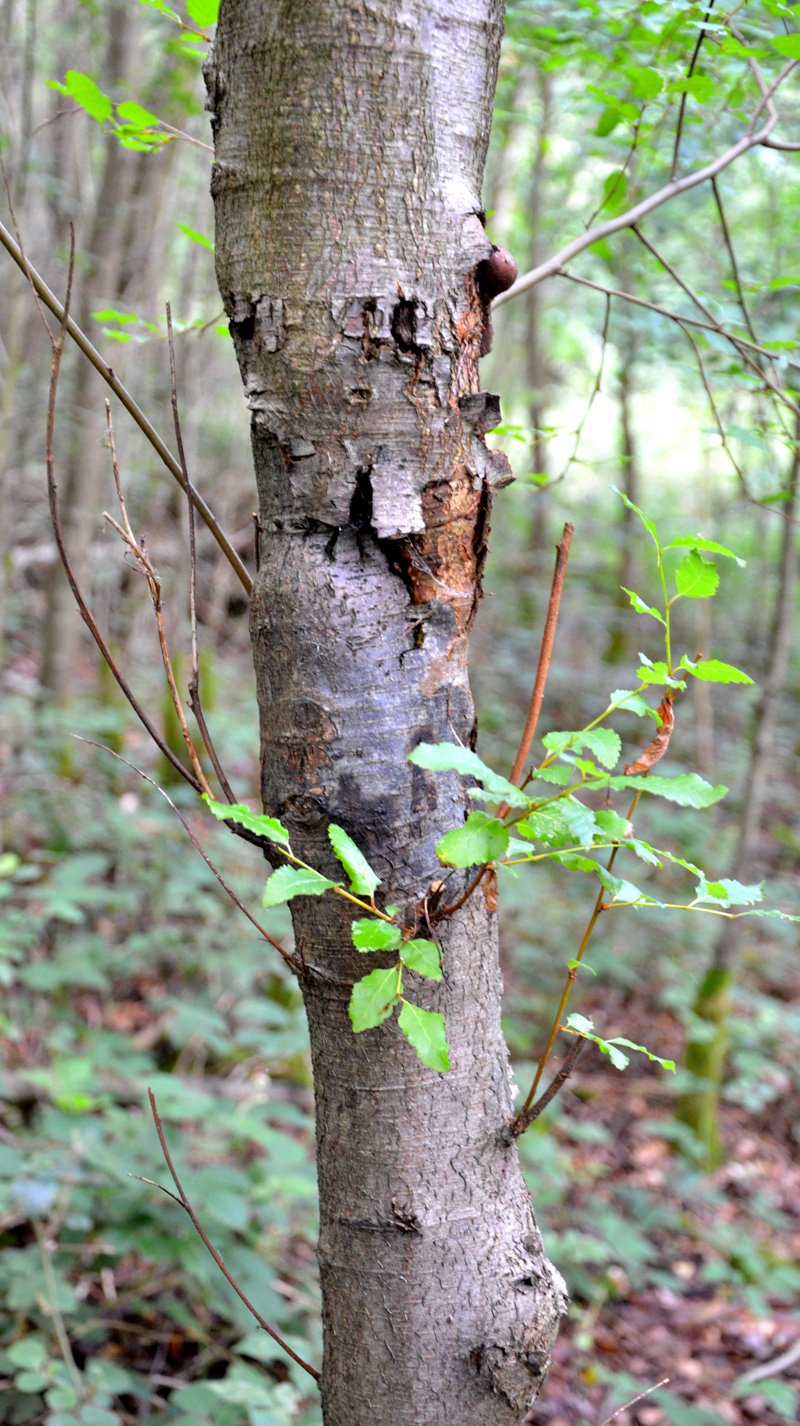 Bark canker with epicormic shoots on Nothofagus obliqua in Britain caused by Phytophthora pseudosyringae ; photo by Bruno Scanu and Joan Webber,nbsp;Forest Research, Farnham, Alice Holt, UK
Bark canker with epicormic shoots on Nothofagus obliqua in Britain caused by Phytophthora pseudosyringae ; photo by Bruno Scanu and Joan Webber,nbsp;Forest Research, Farnham, Alice Holt, UK
Bark canker with epicormic shoots on Nothofagus obliqua in Britain caused by Phytophthora pseudosyringae; photo by Bruno Scanu and Joan Webber, Forest Research, Farnham, Alice Holt, UK
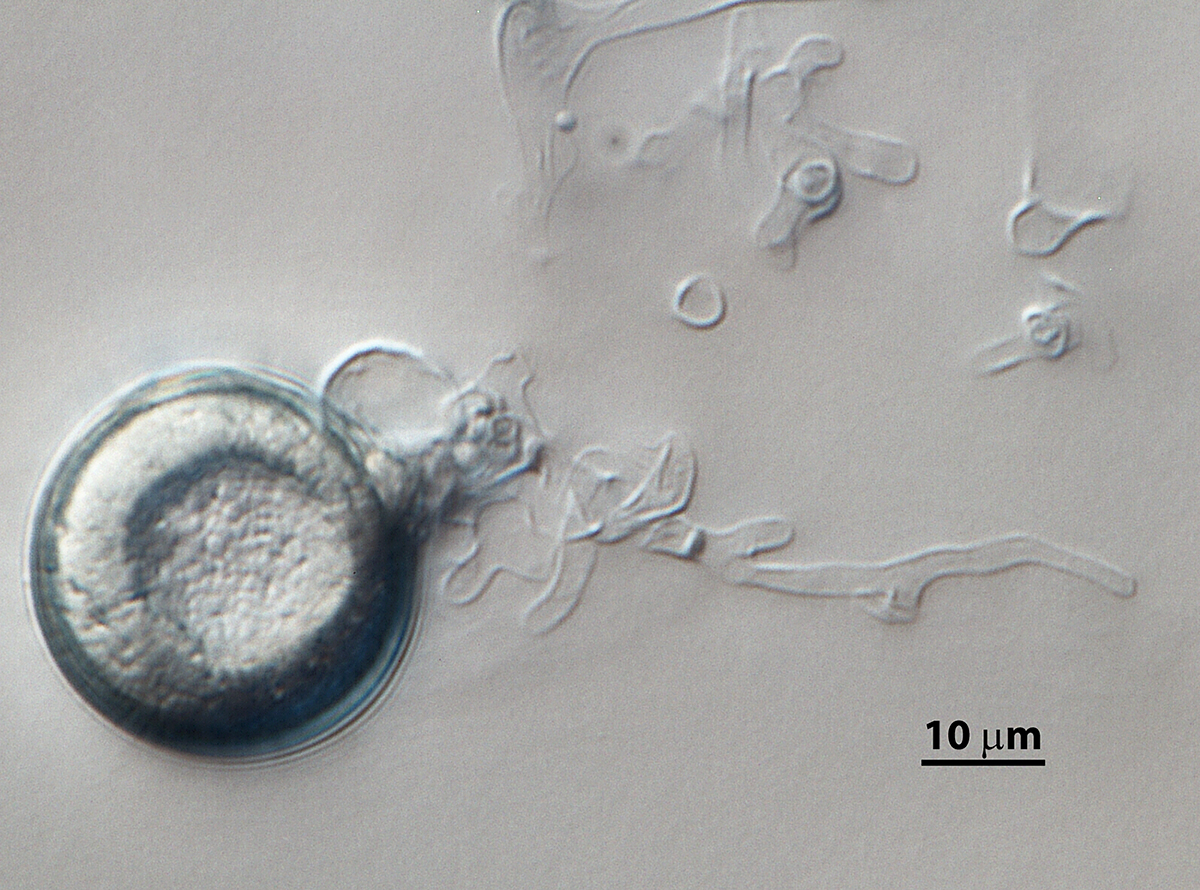 Phytophthora pseudosyringae (ex-type CPHST BL 51G) sexual phase: slightly aplerotic oospore with paragynous antheridium; photonbsp;by Vickie Brewster, USDA-APHIS-PPQ.
Phytophthora pseudosyringae (ex-type CPHST BL 51G) sexual phase: slightly aplerotic oospore with paragynous antheridium; photonbsp;by Vickie Brewster, USDA-APHIS-PPQ.
Phytophthora pseudosyringae (ex-type CPHST BL 51G) sexual phase: slightly aplerotic oospore with paragynous antheridium; photo by Vickie Brewster, USDA-APHIS-PPQ.
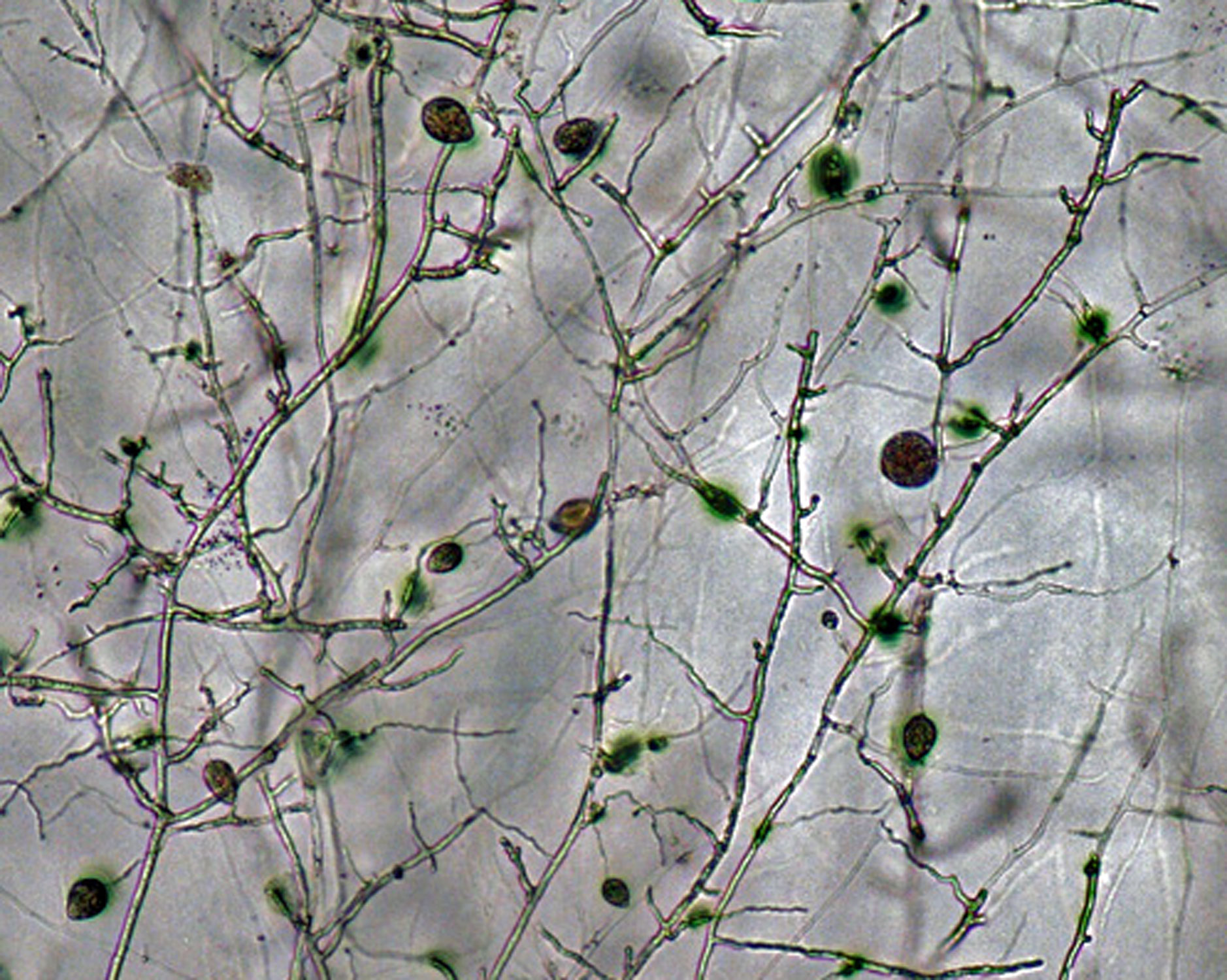 Phytophthora pseudosyringae nbsp;(ex-type CPHST BL 51G) asexual phase:nbsp;sporangia in sporangiophores; photonbsp;by Gloria Abad, USDA-APHIS-PPQ.
Phytophthora pseudosyringae nbsp;(ex-type CPHST BL 51G) asexual phase:nbsp;sporangia in sporangiophores; photonbsp;by Gloria Abad, USDA-APHIS-PPQ.
Phytophthora pseudosyringae (ex-type CPHST BL 51G) asexual phase: sporangia in sporangiophores; photo by Gloria Abad, USDA-APHIS-PPQ.
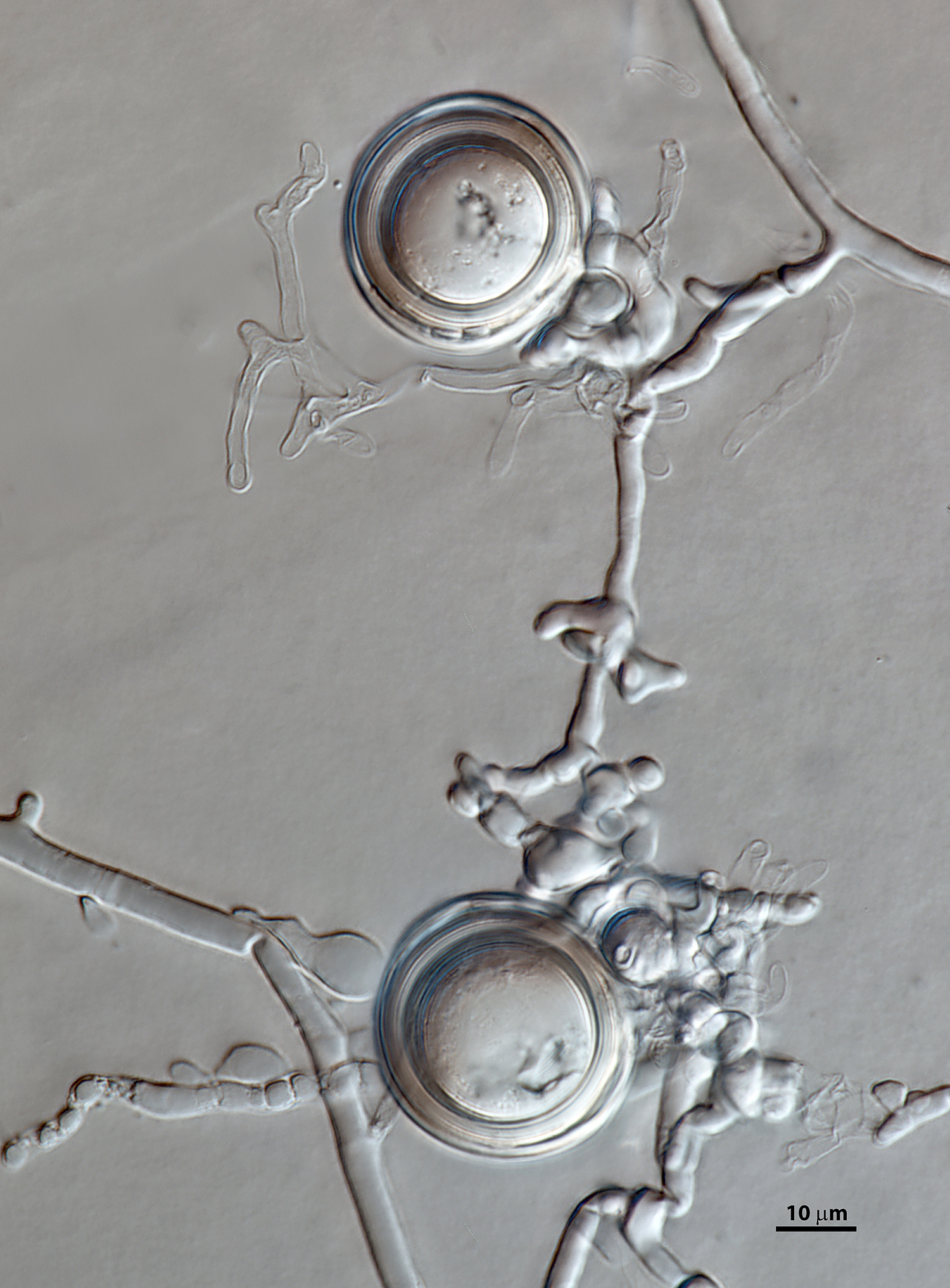 Phytophthora pseudosyringae nbsp;(ex-type CPHST BL 51G) sexual phase: slightly aplerotic oospores with paragynous antheridium and knotted hyphae; photonbsp;by Vickie Brewster, USDA-APHIS-PPQ.
Phytophthora pseudosyringae nbsp;(ex-type CPHST BL 51G) sexual phase: slightly aplerotic oospores with paragynous antheridium and knotted hyphae; photonbsp;by Vickie Brewster, USDA-APHIS-PPQ.
Phytophthora pseudosyringae (ex-type CPHST BL 51G) sexual phase: slightly aplerotic oospores with paragynous antheridium and knotted hyphae; photo by Vickie Brewster, USDA-APHIS-PPQ.
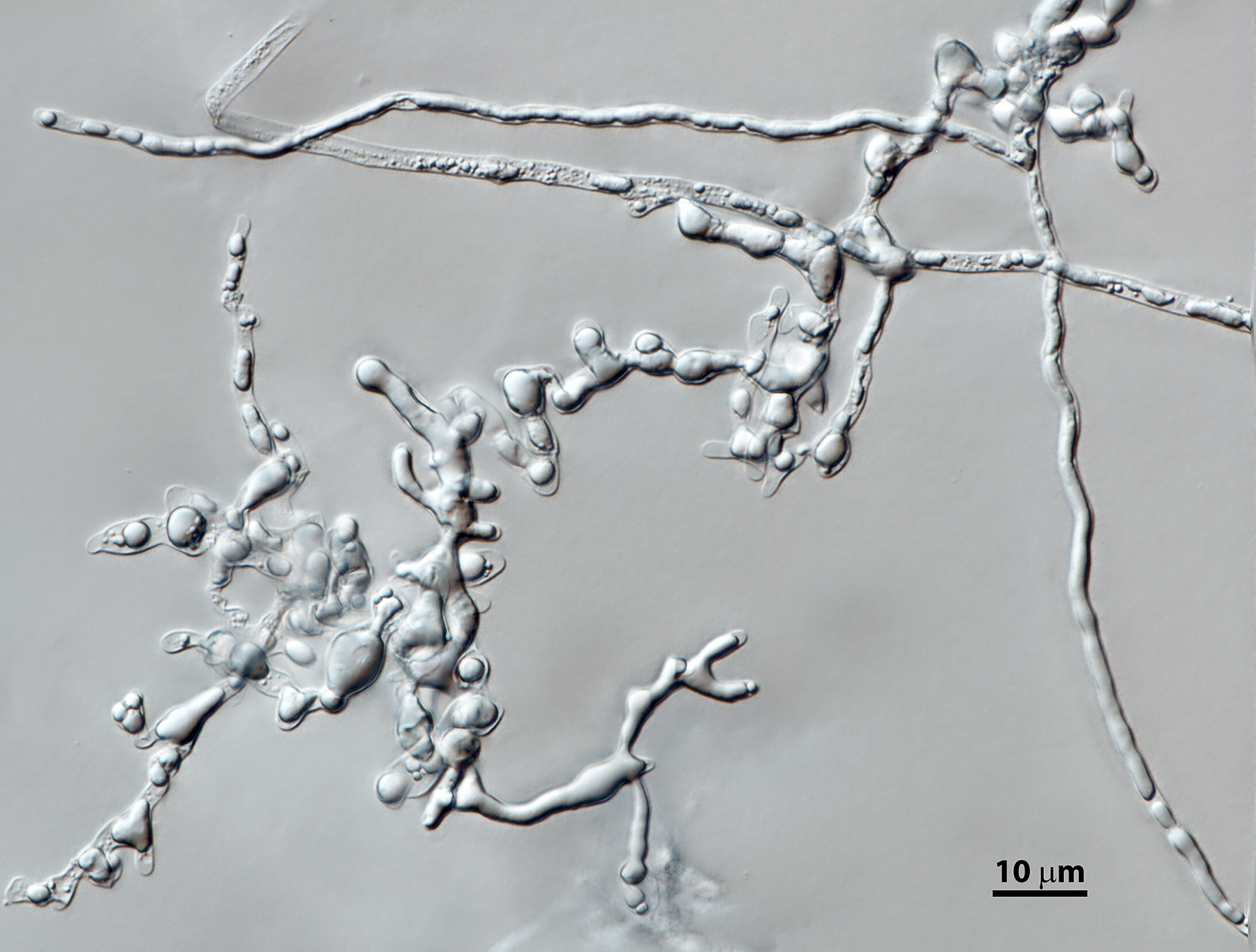 Phytophthora pseudosyringae nbsp;(ex-type CPHST BL 51G) asexual phase: coralloid mycelia; photonbsp;by Gloria Abad, USDA-APHIS-PPQ.
Phytophthora pseudosyringae nbsp;(ex-type CPHST BL 51G) asexual phase: coralloid mycelia; photonbsp;by Gloria Abad, USDA-APHIS-PPQ.
Phytophthora pseudosyringae (ex-type CPHST BL 51G) asexual phase: coralloid mycelia; photo by Gloria Abad, USDA-APHIS-PPQ.
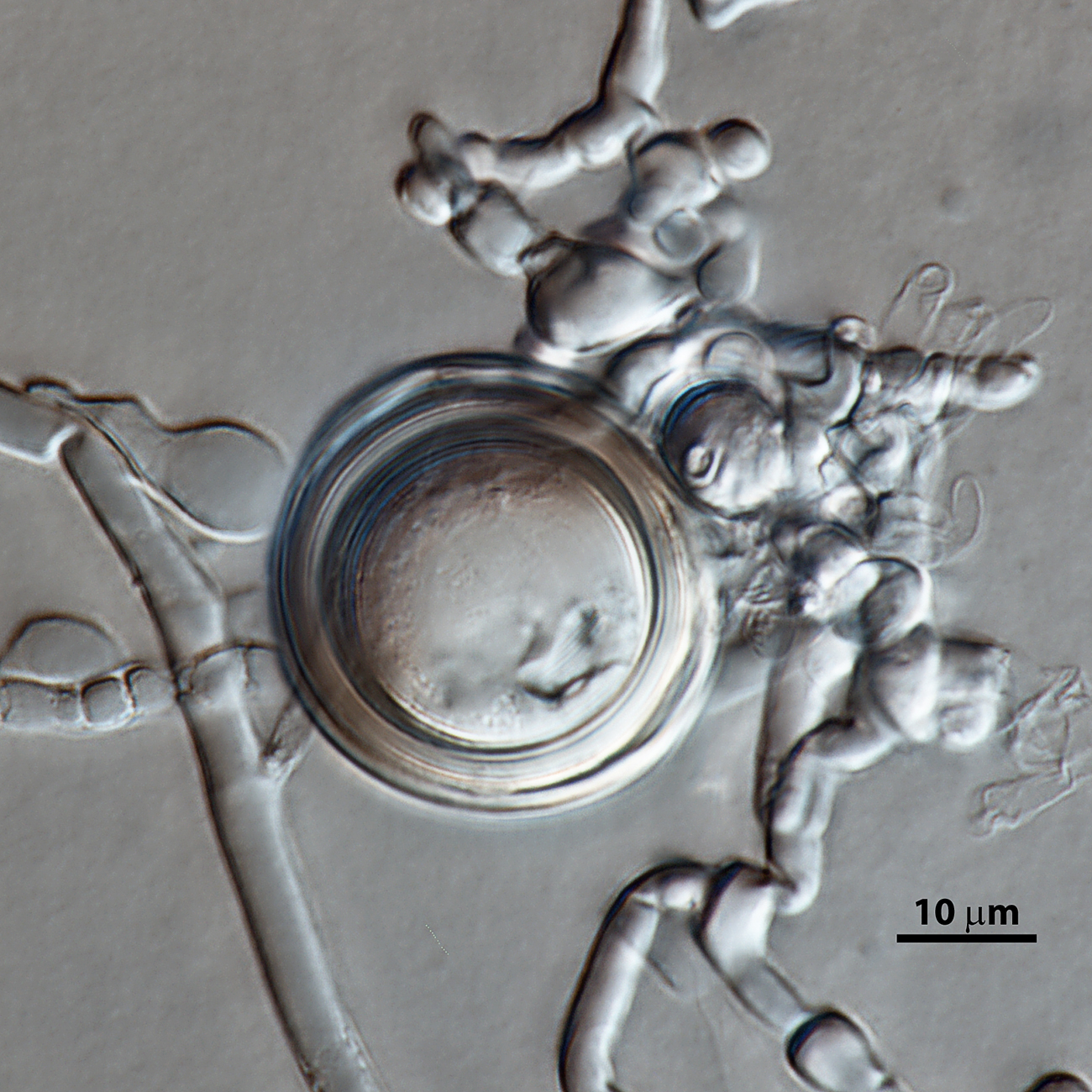 Phytophthora pseudosyringae nbsp;(ex-type CPHST BL 51G) sexual phase: slightly aplerotic oosporenbsp;with paragynous antheridium and knotted hyphae; photonbsp;by Vickie Brewster, USDA-APHIS-PPQ.
Phytophthora pseudosyringae nbsp;(ex-type CPHST BL 51G) sexual phase: slightly aplerotic oosporenbsp;with paragynous antheridium and knotted hyphae; photonbsp;by Vickie Brewster, USDA-APHIS-PPQ.
Phytophthora pseudosyringae (ex-type CPHST BL 51G) sexual phase: slightly aplerotic oospore with paragynous antheridium and knotted hyphae; photo by Vickie Brewster, USDA-APHIS-PPQ.


